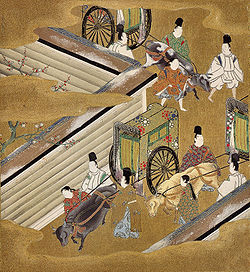Tosa school

Pair of six-panel folding screens; color, ink, and gold on paper; 174.3 × 381.6 cm
The Tosa school of Japanese painting was founded in the 15th century, and was devoted to yamato-e, which are paintings specializing in subject matter and techniques derived from ancient Japanese art, as opposed to schools influenced by Chinese art.
The origins of this school of painting can be traced to Tosa Yukihiro (土佐 行弘), who first used the professional name of Tosa in the early fifteenth century. Later, the school was formally founded by Mitsunobu (1434?–?1525), and he served as official painter at the imperial court, specializing in courtly subjects painted in the yamato-e (やまと絵) style.
During this time, members of the Tosa school almost continuously held the position of head of the Imperial painting bureau (絵所預 edokoroazukari). Until the 17th century, the Tosa school painted for the court and aristocratic patrons, which favored such painting subjects as scenes from the classic Tale of Genji (源氏絵), but in later years, the school's range expanded to include bird-and-flower painting and other Chinese-inspired themes and styles. In general, the Tosa style is characterized by rather flat, decorative compositions, fine linework, great attention to detail, and brilliant color.
History

ch.42 – 匂宮 Niō no Miya ("The Perfumed Prince")
Credited to Tosa Mitsuoki (1617–1691).
The earliest documentary evidence for an artist using the name Tosa are two early 15th century references to a man named Fujiwara Yukihiro (藤原 行広) (fl. 1406 – 1434) who was also known as Tosa Shōgen (土佐 将監), a title derived from his position as governor of Tosa Province. Yukihiro's activity as a painter is known primarily from an inscription on illustrated handscrolls of the Stories of the Origin of Yūzū Nembutsu (融通念仏縁起); 1414, Seiryōji (清涼寺), Kyoto.
Yukihiro's father, Fujiwara Yukimitsu (藤原 行光) (fl. 1352 – 1389) was appointed head of the Imperial painting bureau in 1352, and Yukihiro appears also to have held that post. However, the line of succession from Yukimitsu (considered by some to be the founder of the school) to Tosa Mitsunobu (土佐 光信) (1434 – 1525), who brought the school to a position of prominence in the late 15th century, is still unclear.
Many fine works remain from Mitsunobu's hand. Although he painted both Buddhist paintings and portraits in addition to the standard repertoire of courtly themes, he is best known for his illustrated handscrolls, emaki (絵巻), such as The Legends of Kiyomizu-dera (清水寺縁起). During Mitsunobu's lifetime, the Tosa school may have had some influence on the early development of the Kanō school (狩野派) of painting, in particular, on the use of brilliant colors and gold in combination with the Chinese inspired brushwork, and for various themes for which the Kanō school is known.
Mitsunobu was succeeded by his son, Mitsumochi (光茂) (1496 – ca.1559), under whom the fortunes of the school began to decline. When Mitsumoto (光元) (fl.1530 – 1569), the next head of the painting bureau, was killed in battle in 1569, his post was given to a second son or perhaps a student of Mitsumochi, Tosa Mitsuyoshi (土佐 光吉) (1539 – 1613). Mitsuyoshi eventually left the capital and his post and settled in the city of Sakai (堺), a port city near Osaka, where he sold paintings to the local townspeople. Mitsumochi also moved away from the traditional Tosa themes to specialize in bird-and-flower paintings. During this period, the stewardship of the imperial painting bureau passed from the Tosa school into the hands of Kanō school painters.
Mitsuyoshi's son, Mitsunori (光則) (1583 – 1638) continued to live and work in Sakai, painting for townsmen, until 1634, when he moved to the capital with his eldest son, Mitsuoki (光起) (1617 – 1691) and began painting ceremonial fans for the court. Twenty years later, in 1654, Mitsuoki was appointed head of the imperial painting bureau, thus restoring the fortunes of the Tosa family. Mitsuoki also rejuvenated the traditional Tosa style by introducing elements from Chinese painting. He is particularly noted for his elegant paintings of quail, as for example, the Chrysanthemum and Quail screens which he painted with the help of his son Mitsunari (光成) (1646 – 1710).
Mitsuoki's successors headed the Imperial painting bureau until the end of the Edo period, but their reliance on imitating the style of Mitsuoki, rather than developing new techniques or themes, led to the production of works that were increasingly static and conventional.
Tosa artists of note
- Tosa Yukihiro
- Tosa Mitsunobu
- Tosa Mitsuoki
- Tosa Mitsumochi
- Tosa Mitsumoto
- Tosa Mitsuyoshi
- Tosa Mitsunori
- Iwasa Matabei
References
- Burke, Richard. Murasaki Shikibu: Her Diary and Poetic Memoirs. Princeton University Press, 1982.
- Murase, Miyeko. Iconography of The Tale of Genji. Genji Monogatari Ekotoba. New York and Tokyo: Weatherhill, 1983.
- The Tale of Genji: Legends and Paintings. Introduction by Miyeko Murase. New York: George Braziller, Inc., 2001 ISBN 0-7141-1496-0
